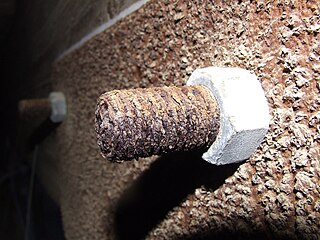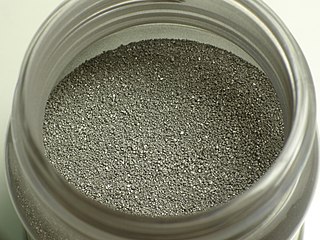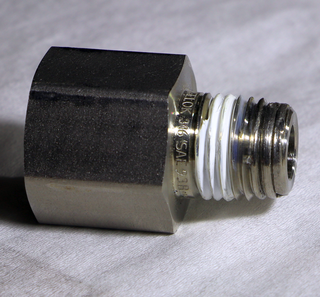Related Research Articles

A lubricant is a substance that helps to reduce friction between surfaces in mutual contact, which ultimately reduces the heat generated when the surfaces move. It may also have the function of transmitting forces, transporting foreign particles, or heating or cooling the surfaces. The property of reducing friction is known as lubricity.

Corrosion is a natural process that converts a refined metal into a more chemically stable oxide. It is the gradual deterioration of materials by chemical or electrochemical reaction with their environment. Corrosion engineering is the field dedicated to controlling and preventing corrosion.

Wear is the damaging, gradual removal or deformation of material at solid surfaces. Causes of wear can be mechanical or chemical. The study of wear and related processes is referred to as tribology.
Tribology is the science and engineering of understanding friction, lubrication and wear phenomena for interacting surfaces in relative motion. It is highly interdisciplinary, drawing on many academic fields, including physics, chemistry, materials science, mathematics, biology and engineering. The fundamental objects of study in tribology are tribosystems, which are physical systems of contacting surfaces. Subfields of tribology include biotribology, nanotribology and space tribology. It is also related to other areas such as the coupling of corrosion and tribology in tribocorrosion and the contact mechanics of how surfaces in contact deform. Approximately 20% of the total energy expenditure of the world is due to the impact of friction and wear in the transportation, manufacturing, power generation, and residential sectors.

Powder metallurgy (PM) is a term covering a wide range of ways in which materials or components are made from metal powders. PM processes are sometimes used to reduce or eliminate the need for subtractive processes in manufacturing, lowering material losses and reducing the cost of the final product. This occurs especially often with small metal parts, like gears for small machines. Some porous products, allowing liquid or gas to permeate them, are produced in this way. They are also used when melting a material is impractical, due to it having a high melting point, or an alloy of two mutually insoluble materials, such as a mixture of copper and graphite.

Titanium diboride (TiB2) is an extremely hard ceramic which has excellent heat conductivity, oxidation stability and wear resistance. TiB2 is also a reasonable electrical conductor, so it can be used as a cathode material in aluminium smelting and can be shaped by electrical discharge machining.

Dental porcelain is a dental material used by dental technicians to create biocompatible lifelike dental restorations, such as crowns, bridges, and veneers. Evidence suggests they are an effective material as they are biocompatible, aesthetic, insoluble and have a hardness of 7 on the Mohs scale. For certain dental prostheses, such as three-unit molars porcelain fused to metal or in complete porcelain group, zirconia-based restorations are recommended.

Galling is a form of wear caused by adhesion between sliding surfaces. When a material galls, some of it is pulled with the contacting surface, especially if there is a large amount of force compressing the surfaces together. Galling is caused by a combination of friction and adhesion between the surfaces, followed by slipping and tearing of crystal structure beneath the surface. This will generally leave some material stuck or even friction welded to the adjacent surface, whereas the galled material may appear gouged with balled-up or torn lumps of material stuck to its surface.
Fretting refers to wear and sometimes corrosion damage of loaded surfaces in contact while they encounter small oscillatory movements tangential to the surface. Fretting is caused by adhesion of contact surface asperities, which are subsequently broken again by the small movement. This breaking causes wear debris to be formed.

Chromium(II) carbide is a ceramic compound that exists in several chemical compositions: Cr3C2, Cr7C3, and Cr23C6. At standard conditions it exists as a gray solid. It is extremely hard and corrosion resistant. It is also a refractory compound, which means that it retains its strength at high temperatures as well. These properties make it useful as an additive to metal alloys. When chromium carbide crystals are integrated into the surface of a metal it improves the wear resistance and corrosion resistance of the metal, and maintains these properties at elevated temperatures. The hardest and most commonly used composition for this purpose is Cr3C2.

Ceramic glaze, or simply glaze, is a glassy coating on ceramics. It is used for decoration, to ensure the item is impermeable to liquids and to minimise the adherence of pollutants.

Thermal barrier coatings (TBCs) are advanced materials systems usually applied to metallic surfaces on parts operating at elevated temperatures, such as gas turbine combustors and turbines, and in automotive exhaust heat management. These 100 μm to 2 mm thick coatings of thermally insulating materials serve to insulate components from large and prolonged heat loads and can sustain an appreciable temperature difference between the load-bearing alloys and the coating surface. In doing so, these coatings can allow for higher operating temperatures while limiting the thermal exposure of structural components, extending part life by reducing oxidation and thermal fatigue. In conjunction with active film cooling, TBCs permit working fluid temperatures higher than the melting point of the metal airfoil in some turbine applications. Due to increasing demand for more efficient engines running at higher temperatures with better durability/lifetime and thinner coatings to reduce parasitic mass for rotating/moving components, there is significant motivation to develop new and advanced TBCs. The material requirements of TBCs are similar to those of heat shields, although in the latter application emissivity tends to be of greater importance.
This is a list of pottery and ceramic terms.
The Archard wear equation is a simple model used to describe sliding wear and is based on the theory of asperity contact. The Archard equation was developed much later than Reye's hypothesis, though both came to the same physical conclusions, that the volume of the removed debris due to wear is proportional to the work done by friction forces. Theodor Reye's model became popular in Europe and it is still taught in university courses of applied mechanics. Until recently, Reye's theory of 1860 has, however, been totally ignored in English and American literature where subsequent works by Ragnar Holm and John Frederick Archard are usually cited. In 1960, Mikhail Mikhailovich Khrushchov and Mikhail Alekseevich Babichev published a similar model as well. In modern literature, the relation is therefore also known as Reye–Archard–Khrushchov wear law. In 2022, the steady-state Archard wear equation was extended into the running-in regime using the bearing ratio curve representing the initial surface topography.
Dry lubricants or solid lubricants are materials that, despite being in the solid phase, are able to reduce friction between two surfaces sliding against each other without the need for a liquid oil medium.

Tribocorrosion is a material degradation process due to the combined effect of corrosion and wear. The name tribocorrosion expresses the underlying disciplines of tribology and corrosion. Tribology is concerned with the study of friction, lubrication and wear and corrosion is concerned with the chemical and electrochemical interactions between a material, normally a metal, and its environment. As a field of research tribocorrosion is relatively new, but tribocorrosion phenomena have been around ever since machines and installations are being used.

In materials science ceramic matrix composites (CMCs) are a subgroup of composite materials and a subgroup of ceramics. They consist of ceramic fibers embedded in a ceramic matrix. The fibers and the matrix both can consist of any ceramic material, including carbon and carbon fibers.

Corium, also called fuel-containing material (FCM) or lava-like fuel-containing material (LFCM), is a material that is created in a nuclear reactor core during a nuclear meltdown accident. Resembling lava in consistency, it consists of a mixture of nuclear fuel, fission products, control rods, structural materials from the affected parts of the reactor, products of their chemical reaction with air, water, steam, and in the event that the reactor vessel is breached, molten concrete from the floor of the reactor room.
Tribofilms are films that form on tribologically stressed surfaces. Tribofilms are mostly solid surface films that result from a chemical reaction of lubricant components or tribological surfaces.
Extreme tribology refers to tribological situations under extreme operating conditions which can be related to high loads and/or temperatures, or severe environments. Also, they may be related to high transitory contact conditions, or to situations with near-impossible monitoring and maintenance opportunities. In general, extreme conditions can typically be categorized as involving abnormally high or excessive exposure to e.g. cold, heat, pressure, vacuum, voltage, corrosive chemicals, vibration, or dust. The extreme conditions should include any device or system requiring a lubricant operating under any of the following conditions:
References
- I.A. Inman. Compacted Oxide Layer Formation under Conditions of Limited Debris Retention at the Wear Interface during High Temperature Sliding Wear of Superalloys, Ph.D. Thesis (2003), Northumbria University, ISBN 1-58112-321-3 (preview)
- S.R. Rose – Studies of the High Temperature Tribological Behaviour of Superalloys, Ph.D. Thesis, AMRI, Northumbria University (2000)
- P.D. Wood – The Effect of the Counterface on the Wear Resistance of Certain Alloys at Room Temperature and 750°C, Ph.D. Thesis, SERG, Northumbria University (1997)
- J.F. Archard and W. Hirst – The Wear of Metals under Unlubricated Conditions, Proc Royal Society London, A 236 (1956) 397-410
- J.F. Archard and W. Hirst – An Examination of a Mild Wear Process Proc. Royal Society London, A 238 (1957) 515-528
- J.K. Lancaster – The Formation of Surface Films at the Transition Between Mild and Severe Metallic Wear, Proc. Royal Society London, A 273 (1962) 466-483
- T.F.J. Quinn – Review of Oxidational Wear. Part 1: The Origins of Oxidational Wear Tribo. Int., 16 (1983) 257-270
- I.A. Inman, P.K. Datta, H.L. Du, Q Luo, S. Piergalski – Studies of high temperature sliding wear of metallic dissimilar interfaces, Tribology International 38 (2005) 812–823 (Elsevier / Science Direct)
- F.H. Stott, D.S. Lin and G.C. Wood – The Structure and Mechanism of Formation of the ‘Glaze’ Oxide Layers Produced on Nickel-Based Alloys during Wear at High Temperatures, Corrosion Science, Vol. 13 (1973) 449-469
- F.H. Stott, J.Glascott and G.C. Wood – Models for the Generation of Oxides during Sliding Wear, Proc Royal Society London A 402 (1985) 167-186
- F.H. Stott – The Role of Oxidation in the Wear of Alloys, Tribology International, 31 (1998) 61-71
- F.H. Stott – High-Temperature Sliding Wear of Metals, Trib. Int., 35 (2002) 489-495
- J. Jiang, F.H. Stott and M.M. Stack – A Mathematical Model for Sliding Wear of Metals at Elevated Temperatures, Wear 181 (1995) 20-31
- T.F.J. Quinn – “Oxidational Wear”, Wear 18 (1971) 413-419
- S.C. Lim – Recent Development in Wear Maps, Tribo. Int., Vol. 31, Nos. 1-3 (1998) 87-97